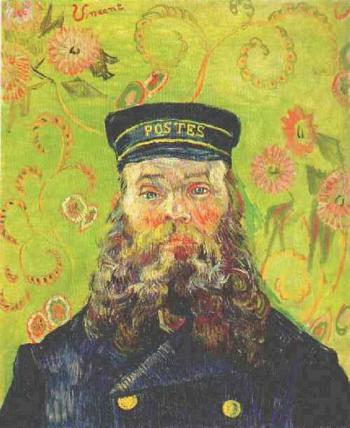Serendip is an independent site partnering with faculty at multiple colleges and universities around the world. Happy exploring!
The Pain of Paintings


It’s always been really hard for me to connect to paintings. I’ve always thought most of them were pretty or interesting (except for Picasso, whose paintings annoyed me beyond all else) but I’ve never really gotten an emotional response from them before. Over the summer, however, I went to the van Gogh museum in Amsterdam. And for some reason, those paintings elicited responses from me that other paintings couldn’t.
I think a large part of it was the eyes. van Gogh’s subjects look directly out of the canvas, into your eyes. They invite a conversation with eyes, between you and the subject, from your time to theirs. This is what occurred in the Barnes Foundation with The Postman.
The first thing I notice about the painting is where it is hung. A corner. They tucked a van Gogh portrait into a corner? Unacceptable. At this point, I decided I didn’t like the Barnes foundation very much.
The next thing I notice is his signature. I absolutely adore the way he signs is name. There’s no tiny last name shoved into the right-hand corner. No, van Gogh signs his first name with whatever color he likes, wherever he likes. In this case, it is at the top of the painting, left-center, large and red-orange against the lime green background.
I get closer and I know what’s coming. I know all the emotions that are about to hit but I can’t stop myself, and I look straight into The Postman’s eyes. And a wave of emotions hit me. They’re all varying degrees of sadness. From depression to misery to regret and on.
I stood in front of the painting for a solid five minutes, before realizing that I was only in the second room of the museum and I needed to go through the rest of it first. But an hour and a half later, I was right back where I started. As the only one in the room, there was no problem standing as close to the painting as possible. I was able to see the brush strokes, the swirls. But more than that, I was able to feel the emotion emitted from the painting. As I look closer at his eyes, I notice that his face appears to be almost split in half. One side looks at me sadly, hoping things could change. The other side stares at me with a raised eyebrow, and I get the sense that he is resigned to this life, whatever this life may be.
As I look into his eyes, jazz music starts to play in the background, and for a second I am jerked harshly back into my own time. It is then that I realize the oddity of the situation I am faced with. I am here, in my own time and place, and he is there, thousands of miles and over a hundred years away. And yet, we are communicating. Or at least, he is communicating with me, which may be the only way we can communicate. Past to future, never the other way around. Suddenly, his eyes seemed even more miserable.
And as I look at the painting, standing further back, then at the edge of the room, then towards the corners, I realize that my eyes keep being drawn back to his eyes. Everything else fades away, becomes unimportant. Without the nose and the beard and the hat and the background the painting wouldn’t be complete, but the only part that really seems to speak are the eyes. And the eyes do speak.
I think that’s why I like van Goghs so much. I’ve been fortunate enough to never really feel that sense of ultimate despair. But I can get that through the eyes of some of his subjects. Looking at this painting allows me to feel a deep emotion I don’t feel very often. It is a completely new experience, one I am so grateful to encounter. Even if it hurts.


